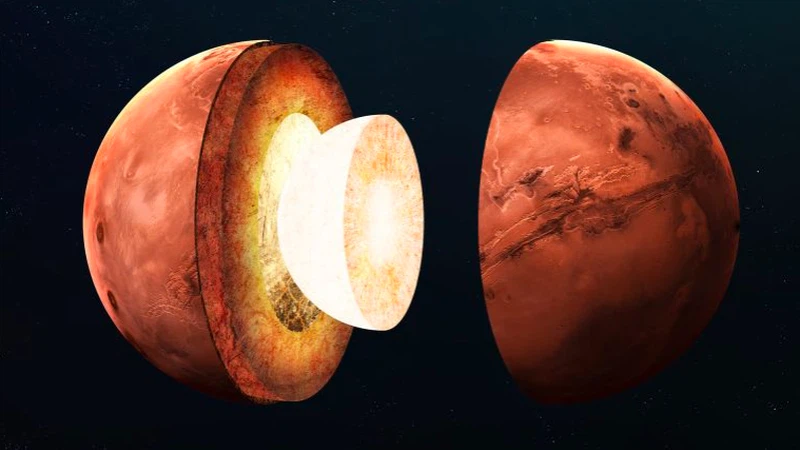Weather of Arabia – Scientists observed seismic waves traveling through the heart of Mars for the first time, and confirmed previous model predictions regarding the formation of the core. An international team of scientists used seismic data obtained by NASA’s “Insight” probe to directly measure the properties of the Martian core, and found a completely liquid iron core with high levels of sulfur and oxygen.
These results were published in the Proceedings of the National Academy of Sciences (PNAS) on April 24, and reveal new insights into how Mars formed and the geological differences between Earth and it, which It may eventually play a role in maintaining the habitability of the planet.
Measurements of this detected sound energy, called seismic waves, indicate that the liquid core is denser and smaller than previously thought, consisting of a mixture of iron and many other elements. The core of Mars is about the same size as the moon and is almost twice its density.
The “Insight” probe landed on Mars in 2018 with the aim of studying seismic waves (NASA)
The first seismic wave
The “Insight” probe landed on Mars in 2018 with the aim of studying seismic waves that travel through the planet’s surface and from the depths of its interior, in order to better understand the geological structure of Mars, by investigating the speed and frequency of seismic waves.
Over a period of 4 years, the probe monitored the pulses of more than a thousand earthquakes on Mars. But in all that time, he detected only two waves on the far side of the planet, which means these pulses pass through the Red Planet’s core.
The lead author of the study, Jessica Irving, professor of seismology and geophysics at the University of Bristol in Britain, says that the research mission was initially scheduled to last about two years.
Although Martian storms accelerated the accumulation of dust and reduced InSight’s energy, NASA extended its stay, so geophysical data, including earthquake signals, continued to accumulate until the end of last year.
In the study, the researchers point out that the first recorded wave of an earthquake on Mars and a meteorite collision crossed the heart of the red planet. Irving says in a statement to Al-Jazeera Net that “no one had ever seen a seismic wave pass through the nucleus of Mars. We waited more than 900 days to monitor the occurrence of one earthquake on the far side of Mars, then after 24 days, there was a meteorite collision.”
When analyzing the transnuclear seismic wave from the two observed events, the team found that the radius of the Martian core ranges from 1,780 to 1,810 kilometers, with a density of about 6,200 kilograms per cubic meter.
The researchers concluded that the core of Mars consists mostly of liquid iron, and sulfur constitutes about 15% of its mass, and a small amount of hydrogen, oxygen and carbon together constitute about 5%, according to the press release issued by the University of Maryland, USA participating in the study.
“Long-range” events located on the other side of the planet are difficult to detect accurately (NASA)
The lead author of the study explained that the so-called “long-range” events, that is, those on the other side of the planet on the opposite side of the probe’s location, are difficult to detect accurately because a large amount of energy is lost or diverted away as the waves travel across the planet. Therefore, the team needed a combination of luck and skill to be able to detect these events and then use them as indicators of the Red Planet’s seismicity.
Irving says that the “Sol 976” earthquake was the most distant event detected by the mission, and adds that “the second distant event is S1000a (S1000a), which is the first event monitored in the thousandth day of operations, which was particularly useful.” Because the examination showed that it was a meteorite collision, so we knew where the seismic signals came from.
The authors used their measurements to build models that describe the physical properties of the Martian core, including its size and the velocity of the elastic wave through it. The results indicated that the Martian core is denser and smaller than previous estimates.
In addition, the team extracted details about the chemical composition of the core, such as the large amount of photosynthetic elements (elements with low atomic numbers) present in Mars’ inner layer, which account for a fifth of the core’s weight.
Source: Al Jazeera
